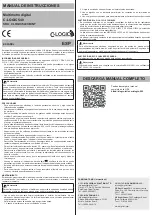
OPERATION INSTRUCTIONS
Measuring Voltage
1. Connect the black test lead to the “COM” Terminal and the red test lead to the “INPUT”
terminal.
2. Set the function switch to V~ or V
⎓
range. Select Auto or Manual range with the
“RANGE” button.
3. In manual range, if the voltage magnitude to be measured is not known beforehand, set
the ranges switch to the highest range position and then reduce it range by range until
satisfactory resolution is obtained.
4. Connect the test leads across the source or load to be measured.
5. Results are displayed on the LCD display. The polarity of the red lead connection will be
indicated when making a DC measurement.
Note:
a. In small ranges, the meter may display an unstable reading when the test leads have not
been connected to the load to be measured. It is normal and will not affect the results.
b. In manual range mode, when the meters show the Overload symbol, “OL”, a higher
range must be selected.
c. To avoid damage to the meter, do not measure a voltage which exceeds 600V DC (for
DC voltage measurement) or 600V AC (for AC voltage measurement).
Measuring Current
1. Connect the black test lead to the “COM” jack. If the current to be measured is less than
200mA, connect the red test lead to the “INPUT” jack. If the current is between 200mA
and 10A, connect the red test lead to the “10A” jack instead.
2. Set the range switch to desired “µA
≂
”, “mA
≂
”, or “A
≂
” range.
If the current magnitude to be measured is not known beforehand, set the ranges switch
to the highest range position and then reduce it range by range until satisfactory
resolution is obtained.
3. Select DC current measurement or AC current measurement with the “Select” Button.
4. Select auto range or manual range with the “Range” button. In manual range, if the
current magnitude to be measured is not known beforehand, select the highest range.
5. Connect test leads in series with the circuit to be measured.
6. Results are displayed on the LCD display. For DC current measurement, the polarity of
the red test lead connection will be indicated as well.
Note:
a. When the display shows the Overload symbol “OL”, a higher range must be selected.
Measuring Resistance
1. Connect the black test lead to the “COM” jack and the red to the “INPUT” jack (Note:
The polarity of the red test lead is positive “+”).
2. Set the range switch to “
”position.
3. Set the “Select” button to “
” range.
4. Select auto range or manual range with the “Range” button. In manual range, if the
current magnitude to be measured is not known beforehand, select the highest range.
5. Connect the test leads across the load to be measured.
6. Results are displayed on the LCD display.
Note:
a. For resistance measurements >1MΩ, the meter may take a few seconds to stabilize
reading. This is normal for high-resistance measurement.






























